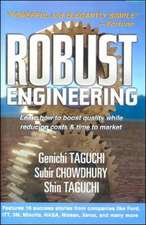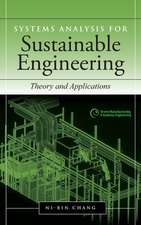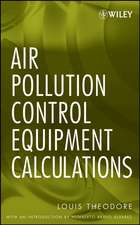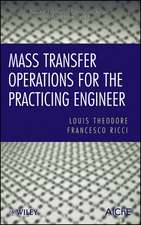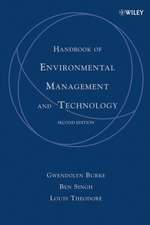Chemical Engineering
Autor Louis Theodoreen Limba Engleză Hardback – 16 iun 2013
Publisher's Note: Products purchased from Third Party sellers are not guaranteed by the publisher for quality, authenticity, or access to any online entitlements included with the product.
A practical, concise guide to chemical engineering principles and applications
Chemical Engineering: The Essential Reference is the condensed but authoritative chemical engineering reference, boiled down to principles and hands-on skills needed to solve real-world problems. Emphasizing a pragmatic approach, the book delivers critical content in a convenient format and presents on-the-job topics of importance to the chemical engineer of tomorrow—OM&I (operation, maintenance, and inspection) procedures, nanotechnology, how to purchase equipment, legal considerations, the need for a second language and for oral and written communication skills, and ABET (Accreditation Board for Engineering and Technology) topics for practicing engineers. This is an indispensable resource for anyone working as a chemical engineer or planning to enter the field.Praise for Chemical Engineering: The Essential Reference:
“Current and relevant...over a dozen topics not normally addressed...invaluable to my work as a consultant and educator.” —Kumar Ganesan, Professor and Department Head, Department of Environmental Engineering,Montana Tech of the University of Montana
“A much-needed and unique book, tough not to like...loaded with numerous illustrative examples...a book that looks to the future and, for that reason alone, will be of great interest to practicing engineers.” —Anthony Buonicore, Principal, Buonicore Partners
Coverage includes:
- Basic calculations and key tables
- Process variables
- Numerical methods and optimization
- Oral and written communication
- Second language(s)
- Chemical engineering processes
- Stoichiometry
- Thermodynamics
- Fluid flow
- Heat transfer
- Mass transfer operations
- Membrane technology
- Chemical reactors
- Process control
- Process design
- Biochemical technology
- Medical applications
- Legal considerations
- Purchasing equipment
- Operation, maintenance, and inspection (OM&I) procedures
- Energy management
- Water management
- Nanotechnology
- Project management
- Environment management
- Health, safety, and accident management
- Probability and statistics
- Economics and finance
- Ethics
- Open-ended problems
Preț: 665.36 lei
Preț vechi: 962.77 lei
-31% Nou
Puncte Express: 998
Preț estimativ în valută:
127.31€ • 132.94$ • 105.13£
127.31€ • 132.94$ • 105.13£
Carte tipărită la comandă
Livrare economică 17-23 aprilie
Preluare comenzi: 021 569.72.76
Specificații
ISBN-13: 9780071831314
ISBN-10: 0071831312
Pagini: 496
Dimensiuni: 224 x 259 x 25 mm
Greutate: 1.07 kg
Editura: McGraw Hill Education
Colecția McGraw-Hill
Locul publicării:United States
ISBN-10: 0071831312
Pagini: 496
Dimensiuni: 224 x 259 x 25 mm
Greutate: 1.07 kg
Editura: McGraw Hill Education
Colecția McGraw-Hill
Locul publicării:United States
Cuprins
Introduction
Part I: Introduction to Engineering
1. Basic Calculations and Key Tables
1–1 Introduction
1–2 Units and Dimensions
1–3 Unit Conversion Factors
1–4 The Gravitational Constant, gc
1–5 Significant Figures and Scientific Notation
1–6 Dimensionless Groups
1–7 Mathematics Tables
1–8 Tables of Atomic Weights
1–9 Water (Steam) Tables
References
2. Process Variables
2–1 Introduction
2–2 Temperature
2–3 Pressure
2–4 Molecular Weights and Moles
2–5 Mass and Volume
2–6 Viscosity
2–7 Surface Tension
2–8 Heat Capacity and Thermal Conductivity
2–9 Diffusion Coefficient
2–10 pH
2–11 Reynolds Number
2–12 The Ideal-Gas Law
2–13 Vapor Pressure, Partial Pressure, and Partial Volume
2–14 Property Estimation
References
3. Numerical Methods and Optimization
3–1 Introduction
3–2 Differentiation
3–3 Numerical Integration
3–4 Simultaneous Linear Algebraic Equations
3–5 Nonlinear Algebraic Equations
3–6 Ordinary Differential Equations
3–7 Partial Differential Equations
3–8 Optimization
References
4. Oral and Written Communication
4–1 Introduction
4–2 Technical Jargon
4–3 Sources of Information
4–4 Oral Presentations
4–5 Technical Writing
4–6 On That First Job
References
5. Second Language(s)
5–1 Introduction
5–2 Early History
5–3 Questions Regarding the Learning Process
5–4 Second-Language Factors
5–5 The Choice of Language
5–6 Barriers
References
6. Chemical Engineering Processes
6–1 Introduction
6–2 The Chemical Industry Today
6–3 Inorganic Chemicals
6–4 Organic Chemicals
6–5 Petrochemicals
6–6 Shreve’s Unit Processes
References
Part II: Unit Operations
7. The Conservation Laws and Stoichiometry
7–1 Introduction
7–2 The Conservation Laws
7–3 Conservation of Mass
7–4 The Conservation Law for Energy
7–5 The Conservation Law for Momentum
7–6 Stoichiometry
References
8. Thermodynamics
8–1 Introduction
8–2 Enthalpy Effects
8–3 Second-Law Calculations
8–4 Phase Equilibrium
8–5 Chemical Reaction Equilibrium
References
9. Fluid Flow
9–1 Introduction
9–2 Basic Laws
9–3 Key Fluid Flow Equations
9–4 Prime Movers
9–5 Fluid-Particle Applications
9–6 Flow-through Porous Media
9–7 Fluidization
References
10. Heat Transfer
10–1 Introduction
10–2 Conduction
10–3 Convection
10–4 Radiation
10–5 Condensation, Boiling, Refrigeration, and Cryogenics
10–6 Heat Exchangers
10–7 The Heat Exchanger Dilemma
References
11. Mass Transfer
11–1 Introduction
11–2 Equilibrium and Rate Principles
11–3 Absorption
11–4 Adsorption
11–5 Distillation
11–6 Liquid-Liquid Extraction and Leaching
References
12. Membrane Separation Processes
12–1 Introduction
12–2 Membrane Separation Principles
12–3 Reverse Osmosis
12–4 Ultrafiltration
12–5 Microfiltration
12–6 Gas Permeation
12–7 Pervaporation
12–8 Electrodialysis
References
13. Chemical Reactors
13–1 Introduction
13–2 Chemical Kinetics
13–3 Arrhenius Equation
13–4 Batch Reactors
13–5 Continuous Stirred Tank Reactors (CSTRs)
13–6 Tubular Flow Reactors
13–7 Catalytic Reactors
13–8 Thermal Effects
13–9 Interpretation of Kinetic Data
References
14. Process Control
14–1 Introduction
14–2 Process Control Fundamentals
14–3 Calibration of Flow and Temperature Transducers
14–4 Sizing Concerns
14–5 Feedback Control
14–6 Feedforward Control
14–7 Cascade Control
References
15. Process and Plant Design
15–1 Introduction
15–2 Preliminary Studies
15–3 Process Schematics
15–4 Material Balances
15–5 Equipment Design
15–6 Instrumentation and Controls
15–7 Design Approach
15–8 The Design Report
Refereces
Part III: Peripheral Topics
16. Biomedical Engineering
16–1 Introduction
16–2 Basic Operations
16–3 Biological Oxygen Demand (BOD)
16–4 Design Considerations
16–5 Design Procedures
References
17. Medical Applications
17–1 Introduction
17–2 Early History
17–3 Definitions
17–4 Key Anatomic Parts
17–5 Current Medical Problem Areas
17–6 Health Risk Factors
17–7 Chemical Engineering Medical Applications
17–8 Chemical Engineering Opportunities
References
18. Legal Considerations
18–1 Introduction
18–2 Laws and Regulations: The Differences
18–3 Intellectual Property Law
18–4 Contract Law
18–5 Tort Law
18–6 Patents
18–7 Copyright Infringement and Interference
18–8 Copyrights
18–9 Trademarks
18–10 The Engineering Professional Licensing Process
References
19. Purchasing Equipment
19–1 Introduction
19–2 Factors in Equipment Selection
19–3 Preliminary Studies
19–4 Equipment Design
19–5 Equipment Specifications
19–6 Materials Selection
19–7 Instrumentation and Controls
19–8 Equipment Selection
19–9 Equipment Fabrication
19–10 Installation Procedures
19–11 Purchasing Equipment Guidelines
References
20. Operation, Maintenance, and Inspection
20–1 Introduction
20–2 Installation Procedures
20–3 Operation
20–4 Maintenance and Inspection
20–5 Testing
20–6 Improving Operation and Performance
20–7 Other Equipment
References
21. Energy Management
21–1 Introduction
21–2 Early History
21–3 Energy Resources
21–4 Energy Quantity and Availability
21–5 General Conservation Practices in Industry
21–6 General Domestic and Commercial Property Conservation Applications
21–7 Architecture and the Role of Urban Planning
21–8 U.S. Energy Policy and Energy Independence
21–9 Future Outlook
References
22. Water Management
22–1 Introduction
22–2 Physicochemical Properties of Water
22–3 The Hydrologic Cycle
22–4 Water Usage
22–5 Regulatory Status
22–6 Acid Rain
22–7 Treatment Processes
22–8 Future Concerns
References
23. Nanotechnology
23–1 Introduction
23–2 Early History
23–3 Fundamentals and Basic Principles
23–4 Nanomaterials
23–5 Production Methods
23–6 Current Applications
23–7 Environmental Concerns
23–8 Current Environmental Regulations
23–9 Future Prospects
References
24. Project Management
24–1 Introduction
24–2 Initiation
24–3 Planning and Scheduling
24–4 Execution and Implementation
24–5 Monitoring and Controlling
24–6 Closing (Project Termination)
24–7 Small-Scale Project Management
24–8 Reports
References
Part IV: Accreditation Board for Engineering and Technology (ABET) Topics
25. Environmental Management
25–1 Introduction
25–2 Environmental Regulations
25–3 Air, Water, and Solid Waste Management
25–4 Classification, Sources, and Effects of Pollutants
25–5 Multimedia Concerns
25–6 ISO 14000
25–7 Energy Conservation
25–8 The Pollution Prevention Concept
25–9 Green Chemistry and Green Engineering
25–10 Sustainability
References
26. Health, Safety, and Accident Management
26–1 Introduction
26–2 Safety and Accidents
26–3 Emergency Planning and Response
26–4 Regulations
26–5 Introduction to Environmental Risk Assessment
26–6 Health Risk Assessment
26–7 Hazard Risk Assessment
References
27. Probability and Statistics
27–1 Introduction
27–2 Probability Definitions and Interpretations
27–3 Introduction to Probability Distributions
27–4 Discrete Probability Distributions
27–5 Continuous Probability Distributions
27–6 Contemporary Statistics
27–7 Regression Analysis
27–8 Analysis of Variance
References
28. Economics and Finance
28–1 Introduction
28–2 Capital Costs
28–3 Operating Costs
28–4 Project Evaluation
28–5 Perturbation Studies in Optimization
28–6 Cost-Benefit Analysis
28–7 Principles of Accounting
References
29. Ethics
29–1 Introduction
29–2 The Present State
29–3 Moral Issues
29–4 Engineering Ethics
29–5 Environmental Justice
29–6 The Pros and Cons of Environmental Justice
References
30. Open-Ended Problems
30–1 Introduction
30–2 The Author’s Approach
30–3 Earlier Experience
30–4 Developing Students’ Power of Critical Thinking
30–5 Creativity and Brainstorming
30–6 Inquiring Minds
30–7 Applications
References
Index
Part I: Introduction to Engineering
1. Basic Calculations and Key Tables
1–1 Introduction
1–2 Units and Dimensions
1–3 Unit Conversion Factors
1–4 The Gravitational Constant, gc
1–5 Significant Figures and Scientific Notation
1–6 Dimensionless Groups
1–7 Mathematics Tables
1–8 Tables of Atomic Weights
1–9 Water (Steam) Tables
References
2. Process Variables
2–1 Introduction
2–2 Temperature
2–3 Pressure
2–4 Molecular Weights and Moles
2–5 Mass and Volume
2–6 Viscosity
2–7 Surface Tension
2–8 Heat Capacity and Thermal Conductivity
2–9 Diffusion Coefficient
2–10 pH
2–11 Reynolds Number
2–12 The Ideal-Gas Law
2–13 Vapor Pressure, Partial Pressure, and Partial Volume
2–14 Property Estimation
References
3. Numerical Methods and Optimization
3–1 Introduction
3–2 Differentiation
3–3 Numerical Integration
3–4 Simultaneous Linear Algebraic Equations
3–5 Nonlinear Algebraic Equations
3–6 Ordinary Differential Equations
3–7 Partial Differential Equations
3–8 Optimization
References
4. Oral and Written Communication
4–1 Introduction
4–2 Technical Jargon
4–3 Sources of Information
4–4 Oral Presentations
4–5 Technical Writing
4–6 On That First Job
References
5. Second Language(s)
5–1 Introduction
5–2 Early History
5–3 Questions Regarding the Learning Process
5–4 Second-Language Factors
5–5 The Choice of Language
5–6 Barriers
References
6. Chemical Engineering Processes
6–1 Introduction
6–2 The Chemical Industry Today
6–3 Inorganic Chemicals
6–4 Organic Chemicals
6–5 Petrochemicals
6–6 Shreve’s Unit Processes
References
Part II: Unit Operations
7. The Conservation Laws and Stoichiometry
7–1 Introduction
7–2 The Conservation Laws
7–3 Conservation of Mass
7–4 The Conservation Law for Energy
7–5 The Conservation Law for Momentum
7–6 Stoichiometry
References
8. Thermodynamics
8–1 Introduction
8–2 Enthalpy Effects
8–3 Second-Law Calculations
8–4 Phase Equilibrium
8–5 Chemical Reaction Equilibrium
References
9. Fluid Flow
9–1 Introduction
9–2 Basic Laws
9–3 Key Fluid Flow Equations
9–4 Prime Movers
9–5 Fluid-Particle Applications
9–6 Flow-through Porous Media
9–7 Fluidization
References
10. Heat Transfer
10–1 Introduction
10–2 Conduction
10–3 Convection
10–4 Radiation
10–5 Condensation, Boiling, Refrigeration, and Cryogenics
10–6 Heat Exchangers
10–7 The Heat Exchanger Dilemma
References
11. Mass Transfer
11–1 Introduction
11–2 Equilibrium and Rate Principles
11–3 Absorption
11–4 Adsorption
11–5 Distillation
11–6 Liquid-Liquid Extraction and Leaching
References
12. Membrane Separation Processes
12–1 Introduction
12–2 Membrane Separation Principles
12–3 Reverse Osmosis
12–4 Ultrafiltration
12–5 Microfiltration
12–6 Gas Permeation
12–7 Pervaporation
12–8 Electrodialysis
References
13. Chemical Reactors
13–1 Introduction
13–2 Chemical Kinetics
13–3 Arrhenius Equation
13–4 Batch Reactors
13–5 Continuous Stirred Tank Reactors (CSTRs)
13–6 Tubular Flow Reactors
13–7 Catalytic Reactors
13–8 Thermal Effects
13–9 Interpretation of Kinetic Data
References
14. Process Control
14–1 Introduction
14–2 Process Control Fundamentals
14–3 Calibration of Flow and Temperature Transducers
14–4 Sizing Concerns
14–5 Feedback Control
14–6 Feedforward Control
14–7 Cascade Control
References
15. Process and Plant Design
15–1 Introduction
15–2 Preliminary Studies
15–3 Process Schematics
15–4 Material Balances
15–5 Equipment Design
15–6 Instrumentation and Controls
15–7 Design Approach
15–8 The Design Report
Refereces
Part III: Peripheral Topics
16. Biomedical Engineering
16–1 Introduction
16–2 Basic Operations
16–3 Biological Oxygen Demand (BOD)
16–4 Design Considerations
16–5 Design Procedures
References
17. Medical Applications
17–1 Introduction
17–2 Early History
17–3 Definitions
17–4 Key Anatomic Parts
17–5 Current Medical Problem Areas
17–6 Health Risk Factors
17–7 Chemical Engineering Medical Applications
17–8 Chemical Engineering Opportunities
References
18. Legal Considerations
18–1 Introduction
18–2 Laws and Regulations: The Differences
18–3 Intellectual Property Law
18–4 Contract Law
18–5 Tort Law
18–6 Patents
18–7 Copyright Infringement and Interference
18–8 Copyrights
18–9 Trademarks
18–10 The Engineering Professional Licensing Process
References
19. Purchasing Equipment
19–1 Introduction
19–2 Factors in Equipment Selection
19–3 Preliminary Studies
19–4 Equipment Design
19–5 Equipment Specifications
19–6 Materials Selection
19–7 Instrumentation and Controls
19–8 Equipment Selection
19–9 Equipment Fabrication
19–10 Installation Procedures
19–11 Purchasing Equipment Guidelines
References
20. Operation, Maintenance, and Inspection
20–1 Introduction
20–2 Installation Procedures
20–3 Operation
20–4 Maintenance and Inspection
20–5 Testing
20–6 Improving Operation and Performance
20–7 Other Equipment
References
21. Energy Management
21–1 Introduction
21–2 Early History
21–3 Energy Resources
21–4 Energy Quantity and Availability
21–5 General Conservation Practices in Industry
21–6 General Domestic and Commercial Property Conservation Applications
21–7 Architecture and the Role of Urban Planning
21–8 U.S. Energy Policy and Energy Independence
21–9 Future Outlook
References
22. Water Management
22–1 Introduction
22–2 Physicochemical Properties of Water
22–3 The Hydrologic Cycle
22–4 Water Usage
22–5 Regulatory Status
22–6 Acid Rain
22–7 Treatment Processes
22–8 Future Concerns
References
23. Nanotechnology
23–1 Introduction
23–2 Early History
23–3 Fundamentals and Basic Principles
23–4 Nanomaterials
23–5 Production Methods
23–6 Current Applications
23–7 Environmental Concerns
23–8 Current Environmental Regulations
23–9 Future Prospects
References
24. Project Management
24–1 Introduction
24–2 Initiation
24–3 Planning and Scheduling
24–4 Execution and Implementation
24–5 Monitoring and Controlling
24–6 Closing (Project Termination)
24–7 Small-Scale Project Management
24–8 Reports
References
Part IV: Accreditation Board for Engineering and Technology (ABET) Topics
25. Environmental Management
25–1 Introduction
25–2 Environmental Regulations
25–3 Air, Water, and Solid Waste Management
25–4 Classification, Sources, and Effects of Pollutants
25–5 Multimedia Concerns
25–6 ISO 14000
25–7 Energy Conservation
25–8 The Pollution Prevention Concept
25–9 Green Chemistry and Green Engineering
25–10 Sustainability
References
26. Health, Safety, and Accident Management
26–1 Introduction
26–2 Safety and Accidents
26–3 Emergency Planning and Response
26–4 Regulations
26–5 Introduction to Environmental Risk Assessment
26–6 Health Risk Assessment
26–7 Hazard Risk Assessment
References
27. Probability and Statistics
27–1 Introduction
27–2 Probability Definitions and Interpretations
27–3 Introduction to Probability Distributions
27–4 Discrete Probability Distributions
27–5 Continuous Probability Distributions
27–6 Contemporary Statistics
27–7 Regression Analysis
27–8 Analysis of Variance
References
28. Economics and Finance
28–1 Introduction
28–2 Capital Costs
28–3 Operating Costs
28–4 Project Evaluation
28–5 Perturbation Studies in Optimization
28–6 Cost-Benefit Analysis
28–7 Principles of Accounting
References
29. Ethics
29–1 Introduction
29–2 The Present State
29–3 Moral Issues
29–4 Engineering Ethics
29–5 Environmental Justice
29–6 The Pros and Cons of Environmental Justice
References
30. Open-Ended Problems
30–1 Introduction
30–2 The Author’s Approach
30–3 Earlier Experience
30–4 Developing Students’ Power of Critical Thinking
30–5 Creativity and Brainstorming
30–6 Inquiring Minds
30–7 Applications
References
Index



